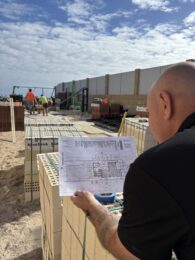What Happens If Your Builder Goes Bust — And You’re Left With a Half-Built Home?
It’s the nightmare no one thinks will happen to them — until it does.
You’re halfway through your build. The walls are up. The frame is locked. You’re already picturing life in your new home.
Then suddenly… silence.
No more emails. No more updates. Phone calls ring out. The site sits untouched for days… then weeks.
And before you get a straight answer, you receive the letter:
Your builder has gone into liquidation.
“What do we do now?”
“Will we lose everything we’ve paid?”
“Will anyone even take on the job?”
If you’ve found yourself worrying about this — you’re not alone. We’ve spoken to families who were caught in this exact scenario. Some were at lock-up. Others were just weeks from completion.
And the truth is, most had no idea anything was wrong until it was too late.
The Fallout of a Builder Collapse Isn’t Just Financial — It’s Emotional
When a builder goes bust, you don’t just lose money. You lose momentum. You lose trust. You lose the sense of certainty that brought you into the process in the first place.
We’ve worked with families who were:
- Paying rent and a mortgage — for months longer than planned
- Dealing with banks who wouldn’t release more funds
- Begging insurers and liquidators for updates
- Struggling to find another builder willing to take over a half-built home
- Mentally and emotionally drained from months of uncertainty
It’s not just frustrating — it’s destabilising. And for some people, it’s enough to walk away from building altogether.
Most Builders Don’t Wave a Red Flag — Until It’s Too Late
That’s what makes this fear so hard to manage.
Builders don’t send warning signs that say:
“Hey, we’re struggling financially — maybe hold off on that deposit.”
Instead, here’s what typically happens:
- You start to notice small delays, but they’re explained away.
- Trades don’t show up when expected.
- You’re told the invoice system is “just a bit behind.”
- Communication slows… but doesn’t stop completely.
Then, almost overnight, you’re locked out of your site — and locked into a legal and financial mess you didn’t sign up for.
Why Builder Collapses Are Happening More Often
The building industry has always had a high rate of insolvency — but in recent years, it’s worsened due to:
- Rising material and labour costs
- Fixed-price contracts that can’t absorb fluctuations
- Poor financial management and overcommitted workloads
- Low profit margins that leave no room for error
Some builders hide the pressure until it breaks. Others genuinely don’t see it coming.
Either way, it’s the client — not the builder — who wears the fallout.
How to Protect Yourself (Before It Happens)
You can’t predict every collapse. But you can reduce your risk — and make sure that if the worst does happen, you’re not left helpless.
Here’s how:
✅ Do your homework
- Ask how long the builder has been in business under their current ABN
- Check for past liquidations, name changes, or trading bans
- Look at ASIC reports and online reviews — not just testimonials
✅ Request financial safeguards
- Confirm that insurance (such as HBCF in WA) is in place before construction starts
- Ask how progress payments are structured — and whether they align with real milestones
- Avoid large upfront deposits with no documented deliverables
✅ Look at their systems
- Builders with poor admin and unclear documentation are more likely to be disorganised — or worse, at risk
- Strong systems, clear invoicing, and predictable updates aren’t just signs of professionalism — they’re signs of stability
✅ Ask the hard question
- “What happens if something goes wrong with your business during our build?”
If they can’t answer it clearly and confidently, that’s a red flag in itself.
If Your Builder Has Gone Bust — Here’s What to Do
If you’re already in this situation, take a breath. You’re not alone. And there is a path forward.
Here’s what we advise:
- Contact your insurer immediately — and request a claims pack
- Engage a qualified building consultant to inspect what’s been done
- Don’t rush into another builder — many won’t touch half-finished homes without careful due diligence
- Keep every document — invoices, contracts, emails, variation orders
- Get independent legal advice before signing anything new
We’ve taken over builds left stranded by liquidation. It’s possible — but it needs to be done carefully, with experienced professionals who can untangle the mess.
Final Thoughts: Peace of Mind Starts With Preparation — Not Panic
No one wants to believe their builder could collapse.
But smart clients don’t ignore the risk — they prepare for it.
And the builders worth working with?
They welcome that conversation.
They don’t get cagey. They don’t dodge your questions.
They have systems in place to protect you, not just their bottom line.
Because when you’re building a home, you’re not just buying bricks and mortar.
You’re investing in certainty — and that starts with knowing your builder can stand the distance.
Want the Checklist We Use to Spot At-Risk Builders?
Inside our free guide, The Smart Home Blueprint, we include a full builder health check — plus what to do if your build ever stalls.
You’ll get:
- Warning signs a builder may be in trouble
- Questions that reveal more than glossy brochures
- Insurance must-haves most people don’t check
- A step-by-step guide to protect your money at every stage
Whether you’re just starting or already mid-build, this guide can give you the confidence you need to move forward safely.
👉 Click here to download your copy of The Smart Home Blueprint




